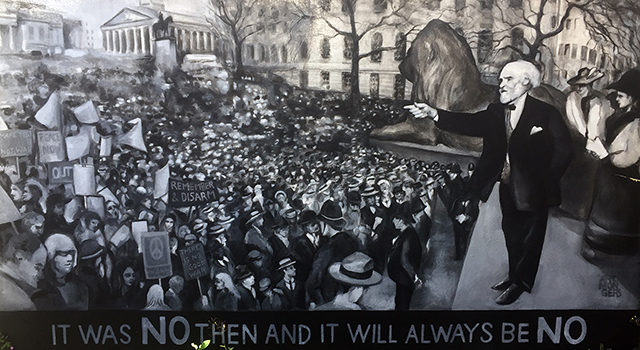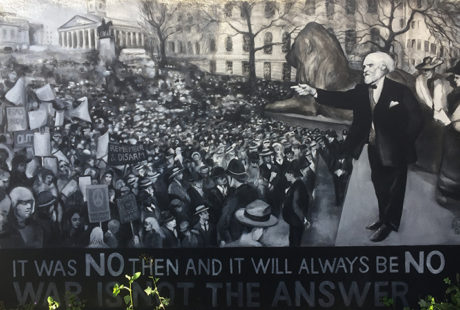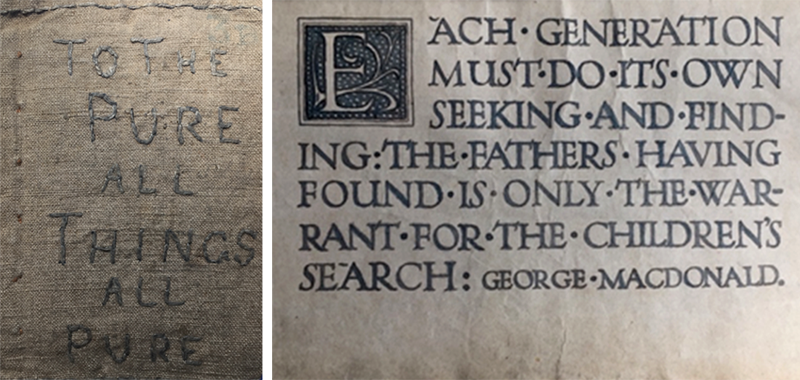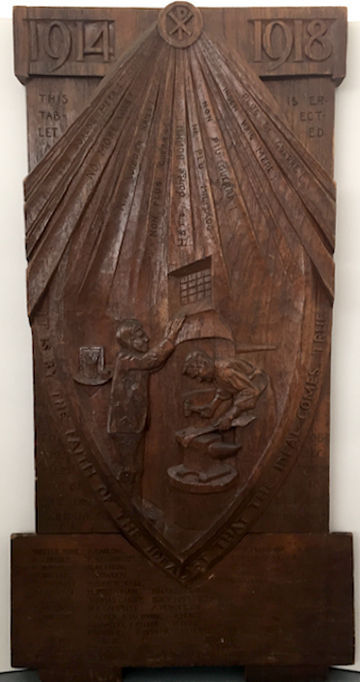Articles

One Comment
By Voices
On 02, Oct 2018 | One Comment | In Belief | By Voices
War is not the Answer: The Peace Pledge Union and the Great War
Chris Hill, Birmingham City University
For the Peace Pledge Union (PPU), established in 1934 by Reverend Dick Shepherd, the Great War occupies a prominent position in its institutional history and memory.
Should a visitor wander down ‘Peace Passage’ to the offices of the PPU in Kentish Town today, they will be struck first of all by a courtyard mural depicting demonstrations in Trafalgar Square [Figure 1]. In the mural, Keir Hardie, the great champion of early labour, bestrides the plinth of Nelson’s column, pointing a finger accusingly at the gathering crowd on the eve of the Great War. The crowd itself represents a sea of time in pacifist history, from the Edwardian opponents of the path to war in 1914 to the anti-nuclear protestors of the past sixty years. The interpretation of the Great War in pacifist history is quite clear – 1914 stands as year zero, the year in which the key debates about war, peace and citizenship were re-forged for the modern age. Whether the clamour to enlist in 1914, the introduction of conscription a year and a half later or the militaristic tendencies of remembrance, the First World War has underwritten the engagement of the PPU with peace politics from its foundation – from the moment that Dick Shepherd asked the British public to take the pledge to renounce war.

Figure 1. A mural depicting a Keir Hardie speech in Trafalgar Square on 2 August 1914 [Photo: Chris Hill]
The centrality of the First World War to the outlook of the PPU is illuminated in particular by the archives held in its offices. Indeed, the artefacts relating to the role of conscientious objectors (COs) in the collection are among the most awe-inspiring and notable. Take, for instance, the Winchester Whisperer, a prison magazine stitched into sackcloth and supposedly hidden behind the raised cistern of a lavatory [Figure 2]. Each section of the magazine was drafted by a different prisoner, with content that ranged from poems and puzzles to pacifist advertisements and satirical illustrations. Legend has it that COs queued outside the lavatory in order to peer over the magazine every time a new issue became available.

Figure 2. The Winchester Whisperer. ‘To the Pure All Things All [sic] Pure’ [Photos: Chris Hill]
Perhaps the most remarkable artefact in the archive, however, is a wooden tablet that serves as a memorial to COs in the Great War. The tablet is remarkable not only because it reveals how an alternative history and memory of the war has been cultivated among pacifists, but also for its own journey through the upheavals of the early twentieth century [Figure 3]. Under a carving that shows a CO with his hands raised towards rays of light through his prison cell, the tablet records the names of 70 British COs who were reported to have died as a result of privations suffered during the First World War. The shafts of light contain the words ‘No More War’ in nine languages and the inscription that wraps around the carving reads: ‘It is by the faith of the idealist that the ideal comes true’ – words that have been attributed to Royle Richmond, one of the COs commemorated.

Figure 3. The Peace Tablet [Photo: Chris Hill]
The tablet was carved by Dorothy Stevens in 1923 at the suggestion of Martha Steinitz, secretary of the German section to the War Resisters’ International (WRI). Having been erected at the headquarters of the German WRI in Berlin, the tablet soon had to be moved following Hitler’s rise to power in 1933. It was displayed and then hidden by another secretary of the German WRI, Arnold Kalisch, in a Peace House in Southern Denmark – itself occupied by Nazi Germany from 1940. In the aftermath of the Second World War, the tablet was re-erected in Peace House until Kalisch’s death in 1957, when his widow and the WRI placed it on permanent loan to the PPU. It stands today as the centrepiece of the study room in the PPU offices down Peace Passage.
The journey of the tablet can be seen as allegorical for the history of absolute pacifism as a whole. However ‘peace’ has been constructed and bent out of shape by historical forces – however difficult or marginal the position of peace at various times in twentieth century history – the dedication of a minority to peace as an absolute ideal has survived, even if only underground. The historical mission of the PPU has been and remains to show the relevance of absolute pacifism no matter the circumstances and no matter the war, including the fight against Hitler. In this mission, it is the history of the First World War – far more so than that of the Second – that has provided the PPU with the most direction and meaning.
Chris Hill, August 2018.
-
As the son of a Conscientious Objector , William Henry Saunders, imprisoned for over three years for his principles in WW1 , and as a CO myself in WW2, serving in the Friends Relief Service, both my father was in his lifetime , and I have been a PPU member since 1942. My pacifist views have never wavered and I am still active as chairman of Conwy County Peace Group to this day. I have always supported PPU principles.
Submit a Comment



Comments